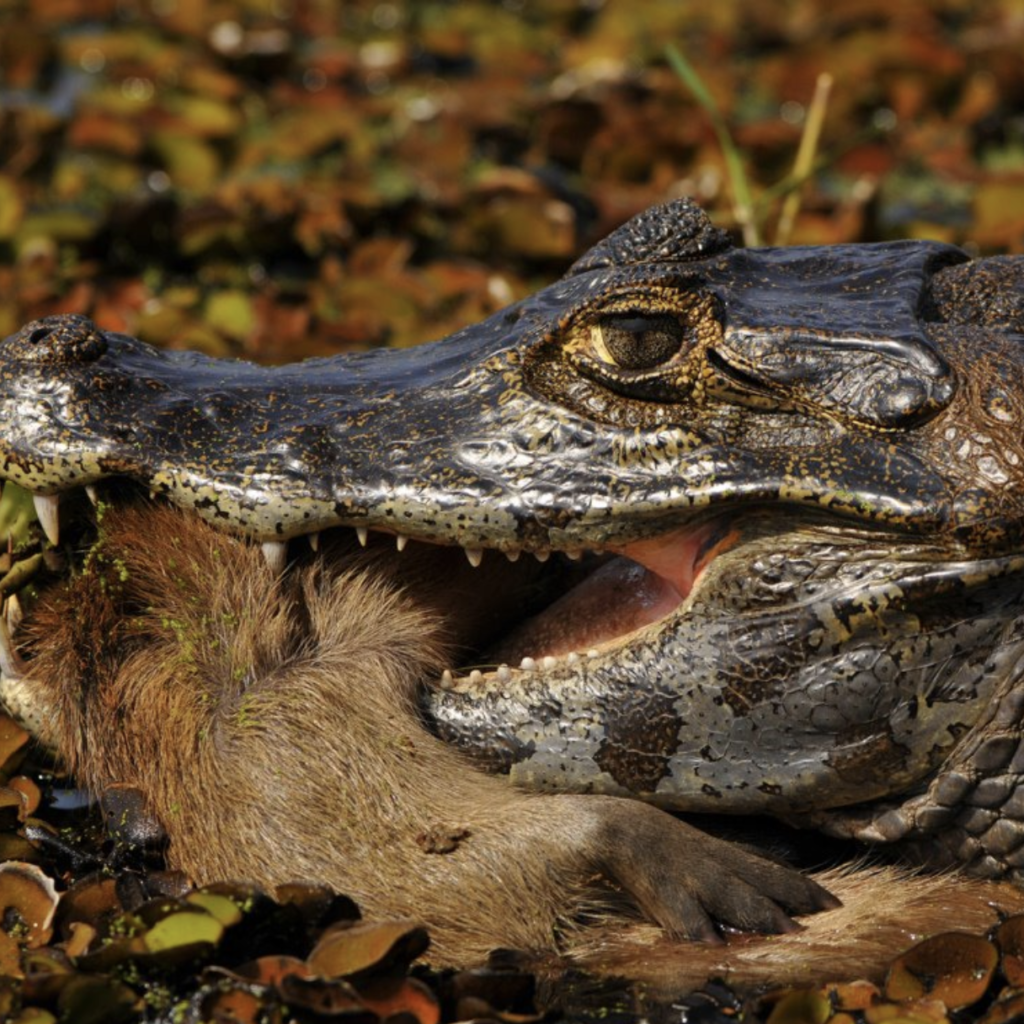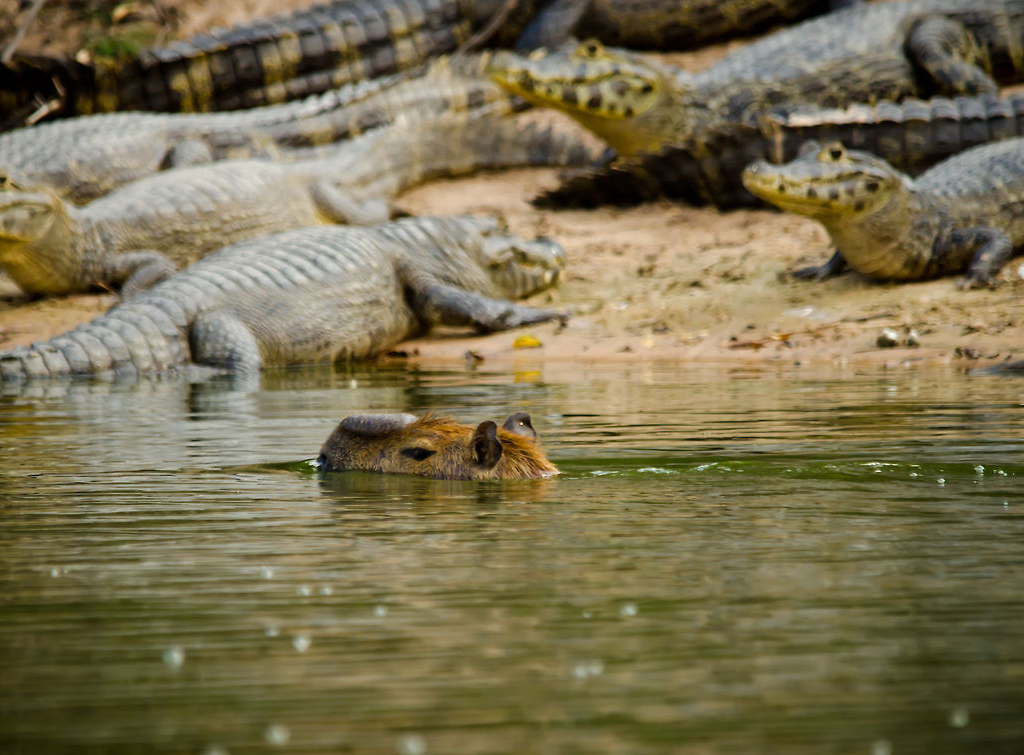Introduction
Capybaras and crocodiles are two iconic species. The species coexist in lots of wetlands in South America. Capybaras are the largest rodents in the world. Crocodiles are the most strong animal within the world. The relationship among the capybara and the crocodile is very extraordinary and unusual. Do crocodiles eat capybaras? Or have these rodents observed some strategies to keep away from being on the menu?

Overview of Crocodiles
Crocodiles have powerful jaws with many conical teeth and short legs with clawed webbed toes. They share a unique body form that allows the eyes, ears, and nostrils to be above the water’s surface, while most of the animal is hidden below. The tail is long and massive, and the skin is thick and plated. Crocodiles are the largest and heaviest of present-day reptiles.
Introduction to Capybaras
On the other hand, capybaras (Hydrochoerus hydrochaeris), whose homeland is South America, are herbivorous mammals. They are well known for their semi-aquatic lifestyle and are often found in areas with water, such as rivers, lakes, and swamps. Capybaras are social animals, living in groups and exhibiting complex behaviors. Their size and stocky bodies make them ideal for moving through aquatic and terrestrial habitats.

| Aspect | Crocodiles | Capybaras |
|---|---|---|
| Taxonomic Family | Crocodylidae | Caviidae |
| Habitat | Freshwater habitats like rivers, lakes, etc. | Near water bodies such as rivers, ponds, marshes, etc. |
| Diet | Carnivorous, prey on various animals | Herbivorous, primarily feed on plants |
| Social Behavior | Solitary or social, depending on the species | Highly social, live in groups |
| Adaptations | Streamlined bodies, powerful jaws, Excellent swimming capabilities | Keen sense of smell and hearing, agility, and speed form large groups for safety |
| Predation Tactics | Ambush predators, utilize stealth and patience | Vigilance, speed, group defense mechanisms |
| Interaction with Ecosystem | Predators, maintain ecosystem balance | Prey, shape, vegetation structure, and nutrient cycling |
| Conservation Status | Varies by species, some are threatened | Least Concern according to IUCN |
While both widely inhabit slow-moving rivers, floodplains, swamps, and wet grasslands in Central and South America, crocodiles and capybaras differ vastly in their lifestyles. As herbivores, capybaras forage on aquatic and terrestrial plants. Their large size and semiaquatic behavior make them less prone to maximum predators.
On the other hand, crocodiles are apex predators that aggressively hunt a lot of prey. They are essential in controlling the populations of species below in the food chain since they are apex consumers. But do they have a taste for gigantic capybaras as well?
While both widely inhabit slow-moving rivers, floodplains, swamps, and wet grasslands in Central and South America, crocodiles and capybaras differ vastly in their lifestyles. As herbivores, capybaras forage on aquatic and terrestrial plants. Their large size and semiaquatic behavior make them less prone to maximum predators.
Adaptations for Avoidance
Capybaras possess a few adaptations that deter crocodilian predation:
- Their herd behavior likely functions as a predator dilution effect, confusing stalking crocodiles.
- They seek refuge from predators by submerging themselves or retreating into dense reed beds, where their stalking skills are negated.
- Capybaras can run swiftly in short bursts if threatened, and they are agile swimmers despite their bulky frames.
- Many live in proximity to human habitations, which may deter crocodiles from venturing near.
While these adaptations suggest capybaras avoid becoming crocodile meals, conclusive evidence is still emerging on the real frequency and dynamics of predation. Let’s explore ongoing research further.
Crocodile Hunting Strategies
Crocodiles use different hunting methods, such as shooting, dragging, and stalking, to kill their prey. Crocodiles use their patience and stealth to catch capybaras, usually targeting individuals or small groups that are separated from the safety of the herd. They are deadly predators that may defeat even large animals like capybaras because of their strong jaws and sharp teeth.

Ongoing Studies Reveal the Truth
Recent scientific studies are providing valuable insights.
- A few observational accounts and signs of unsuccessful predation attempts have been documented, but direct predation events are rarely seen in the field.
- Stable isotope analysis of crocodile scales and teeth found no or very low uptake of capybara-derived isotopic signatures, indicating infrequent predation.
- Croc diets studied via stomach content analysis and fecal sampling also failed to detect capybara consistently.
- Simulated predation experiments showed that sub-adult crocs were often unable to catch and subdue large capybaras.
Together, these findings suggest that while opportunistic and isolated instances of predation may occur, mature capybaras successfully avoid being regularly preyed upon by their toothy neighbors through evolved strategies and behaviors. Their large size simply isn’t conducive for the crocs.
Significance for Ecosystems
By seldom being prey, capybaras fulfill vital functions undisturbed in wetland communities:
- Engineering habitat structure through foraging
- Recycling nutrients via wallowing and feces
- Serving as a food source for jaguars and pumas
- Maintaining population numbers of preferred plant species
Their coexistence with crocodiles is thus important for the balance and biodiversity of these shared ecosystems. Any disruptions could negatively impact dynamics at multiple trophic levels.

Conservation Efforts
The ecological balance of South American rivers and wetlands depends on conservation efforts to protect capybaras and crocodiles. Community conservation measures, enforcement of anti-poaching laws, and habitat protection are essential to protecting these iconic species and their habitats. By preserving the integrity of these ecosystems, we ensure that crocodiles and capybaras continue to coexist for future generations to enjoy and learn.
Conclusion
In conclusion, the relationship between predators and prey in South American ecosystems can be summarised with the question, “Do crocodiles eat capybaras?” Capybaras develop many strategies to avoid appearing on their neighbors’ menus. Predation is an important part of their interactions. It also highlights the importance of biodiversity and habitat conservation. By understanding the changing nature of ecosystems, we can work for the survival of animals and their habitats.
You can also visit https://www.britannica.com/animal/crocodile-order
FAQs
1. Do crocodiles in South America only kill capybara?
Do crocodiles eat capybaras? In South America, crocodiles do not only kill capybaras. Crocodiles are predators and can also prey on many animals, including fish, birds, and small animals.
2. How do capybaras protect themselves from crocodiles?
Capybaras use loads of protective techniques to defend themselves from crocodiles, which include alertness, pace, and group formation. They reduce prediction by thinking speedy, escaping from risk quickly, and detecting feasible risks.
3. Are South America’s crocodiles a threat to humans?
Crocodiles can attack people in regions where they coexist, but rarely. Human activities and occupation of areas close to water are reasons for human-crocodile encounters.
4. Do crocodiles play an important role in South American ecosystems?
Crocodiles play an essential role in balancing ecosystems with the aid of regulating prey populations. They help in shaping habitat structure and contributing to nutrient cycling.
5. Is there a special conservation project to protect crocodiles in South America?
Yes, many conservation strategies have been implemented to protect crocodiles in South America, including covered regions, breeding, and intra-community cooperation.
6. How can tourists safely see crocodiles and capybaras in South America?
Observe crocodiles and capybaras with experienced guides and follow safety procedures. For human safety and wildlife protection, maintain a safe distance and respect habitats.


Your blog is a constant source of inspiration for me. Your passion for your subject matter is palpable, and it’s clear that you pour your heart and soul into every post. Keep up the incredible work!
Great read with a touch of humor! For further details, check out: READ MORE. What are your thoughts?